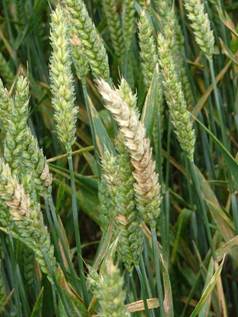气候变化增加小麦患病的风险
来源:《Annals of Applied Biology》
作者:Zhang X.等
时间:2014-03-24

Fusarium ear blight on wheat crop.
根据国际研究人员的研究,在未来十到二十年,由于气候变化造成的影响,一些小麦患严重流行病的风险可能会增加。研究人员在中国进行了一项调查,建立了气象与小麦穗枯病流行严重程度之间的关系模型。这种气象基础模型将被用来预测2020到2050年间未来气象情况对疾病严重程度的影响。
研究表明,气候变化将增加本世纪中期(2020-2050)中国中部冬小麦患严重耳疫流行病的风险。
气候变化模型预测的英国暖湿冬季气候对英国小麦的影响也有类似的结论。这表明,英国也将遭遇较大的小麦镰刀菌穗枯病爆发事件,大大影响了人类的一个最大主食作物。
世界上超过十亿人没有足够的食物,我们未来的粮食安全受到气候变化和不断增长人口的威胁。因此,提高全球作物如镰刀菌穗枯病等疾病的控制是要点。(编译:中国科学院成都生物研究所 王芋华,王海燕)
Climate change increases risk of fusarium ear blight on wheat in central China
Abstract To estimate potential impact of climate change on wheat fusarium ear blight (FEB), simulated weather for the A1B climate change scenario was input into a model for estimating FEB in central China. In this article, a logistic weather-based regression model for estimating incidence of wheat FEB in central China was developed, using up to 10 years (2001–2010) of disease, anthesis date and weather data available for 10 locations in Anhui and Hubei provinces. In the model, the weather variables were defined with respect to the anthesis date for each location in each year. The model suggested that incidence of FEB is related to number of days of rainfall in a 30-day period after anthesis and that high temperatures before anthesis increase the incidence of disease. Validation was done to test whether this relationship was satisfied for another five locations in Anhui province with FEB data for 4–5 years but no nearby weather data, using simulated weather data obtained employing the regional climate modelling system PRECIS. How climate change may affect wheat anthesis date and FEB in central China was investigated for period 2020–2050 using wheat growth model Sirius and climate data simulated using PRECIS. The projection suggested that wheat anthesis dates will generally be earlier and FEB incidence will increase substantially for most locations.
原文链接:http://onlinelibrary.wiley.com/doi/10.1111/aab.12107/pdf




